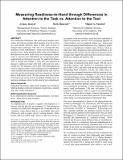Files in this item
Measuring readiness-to-hand through differences in attention to the task vs. attention to the tool
Item metadata
| dc.contributor.author | Alzayat, Ayman | |
| dc.contributor.author | Hancock, Mark | |
| dc.contributor.author | Nacenta, Miguel | |
| dc.date.accessioned | 2017-10-20T13:30:13Z | |
| dc.date.available | 2017-10-20T13:30:13Z | |
| dc.date.issued | 2017-10-17 | |
| dc.identifier | 251360505 | |
| dc.identifier | a2035549-6357-4688-b8db-93060bb71609 | |
| dc.identifier | 85034748485 | |
| dc.identifier | 000494261900007 | |
| dc.identifier.citation | Alzayat , A , Hancock , M & Nacenta , M 2017 , Measuring readiness-to-hand through differences in attention to the task vs. attention to the tool . in Proceedings of the 2017 ACM International Conference on Interactive Surfaces and Spaces (ISS '17) . ACM , pp. 42-51 , Interactive Surfaces aand Spaces , Brighton , United Kingdom , 17/10/17 . https://doi.org/10.1145/3132272.3134114 | en |
| dc.identifier.citation | conference | en |
| dc.identifier.isbn | 978-1-4503-4691-7/17/10 | |
| dc.identifier.other | ORCID: /0000-0002-9864-9654/work/37898078 | |
| dc.identifier.uri | https://hdl.handle.net/10023/11891 | |
| dc.description.abstract | New interaction techniques, like multi-touch, tangible inter-action, and mid-air gestures often promise to be more intuitive and natural; however, there is little work on how to measure these constructs. One way is to leverage the phenomenon of tool embodiment—when a tool becomes an extension of one’s body, attention shifts to the task at hand, rather than the tool itself. In this work, we constructed a framework to measure tool embodiment by incorporating philosophical and psychological concepts. We applied this framework to design and conduct a study that uses attention to measure readiness-to-hand with both a physical tool and a virtual tool. We introduce a novel task where participants use a tool to rotate an object, while simultaneously responding to visual stimuli both near their hand and near the task. Our results showed that participants paid more attention to the task than to both kinds of tool. We also discuss how this evaluation framework can be used to investigate whether novel interaction techniques allow for this kind of tool embodiment. | |
| dc.format.extent | 1477463 | |
| dc.language.iso | eng | |
| dc.publisher | ACM | |
| dc.relation.ispartof | Proceedings of the 2017 ACM International Conference on Interactive Surfaces and Spaces (ISS '17) | en |
| dc.subject | Embodied interaction | en |
| dc.subject | Multi-touch | en |
| dc.subject | Tangible user interfaces | en |
| dc.subject | Tabletop displays | en |
| dc.subject | Physical interaction | en |
| dc.subject | Intuitiveness | en |
| dc.subject | Naturalness | en |
| dc.subject | User centric interaction | en |
| dc.subject | BF Psychology | en |
| dc.subject | QA75 Electronic computers. Computer science | en |
| dc.subject | NDAS | en |
| dc.subject.lcc | BF | en |
| dc.subject.lcc | QA75 | en |
| dc.title | Measuring readiness-to-hand through differences in attention to the task vs. attention to the tool | en |
| dc.type | Conference item | en |
| dc.contributor.institution | University of St Andrews. School of Computer Science | en |
| dc.identifier.doi | https://doi.org/10.1145/3132272.3134114 |
This item appears in the following Collection(s)
Items in the St Andrews Research Repository are protected by copyright, with all rights reserved, unless otherwise indicated.

